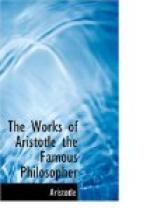(3) The third thing which makes up the secundine in the alantois, of which there is a great dispute amongst anatomists. Some say there is such a thing, and others that there is not. Those who will have it to be a membrane, say it is white, soft and exceedingly thin, and just under the placenta, where it is knit to the urachos, from which it receives the urine; and its office is to keep it separate from the sweat, that the saltness of it may not offend the tender skin of the child.
(4) The fourth, and last covering of the child is called amnios; and it is white, soft and transparent, being nourished by some very small veins and arteries. Its use is, not only to enwrap the child, but also to retain the sweat of the child.
Having thus described the parts proper to a child in the womb, I will next proceed to speak of the formation of the child therein, as soon as I have explained the hard terms of the section, that those for whose help it is designed, may understand what they read. A vein is that which receives blood from the liver, and distributes in several branches to all parts of the body. Nerve is the same with sinew, and is that by which the brain adds sense and motion to the body. Placenta, properly signifies sugar cake; but in this section it is used to signify a spongy piece of flesh resembling a cake, full of veins and arteries, and is made to receive a mother’s blood appointed for the infant’s nourishment in the womb. The chorion is an outward skin which compasseth the child in the womb. The amnios is the inner skin which compasseth the child in the womb. The alantois is the skin that holds the urine of the child during the time that it abides in the womb. The urachos is the vessel that conveys the urine from the child in the womb to the alantois. I now proceed to
SECT. II.—Of the Formation of the Child in the Womb.
To speak of the formation of the child in the womb, we must begin where nature begins, and, that is at the act of coition, in which the womb having received the generative seed (without which there can be no conception), the womb immediately shuts up itself so close that the point of a needle cannot enter the inward orifice; and this it does, partly to hinder the issuing out of the seed again, and partly to cherish it by an inward heat, the better to provoke it to action; which is one reason why women’s bellies are so lank at their first conception. The woman having thus conceived, the first thing which is operative in conception is the spirit whereof the seed is full, which, nature quickening by the heat of the womb, stirs up the action. The internal spirits, therefore, separate the parts that are less pure, which are thick, cold and clammy, from those that are more pure and noble. The less pure are cast to the outside, and with these seed is circled round and the membrane made, in which that seed that is most pure is wrapped round and kept close together, that it may be defended from cold and other accidents, and operate the better.




